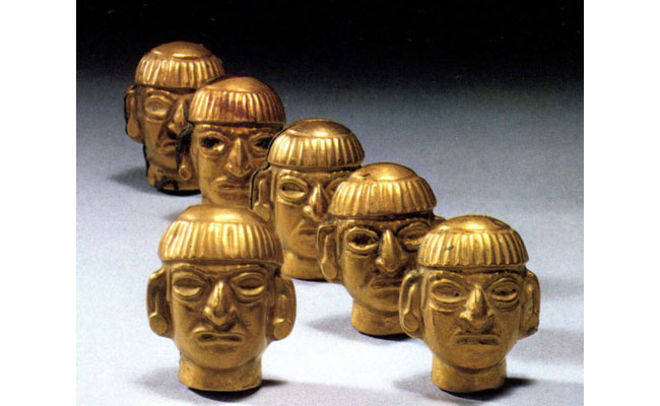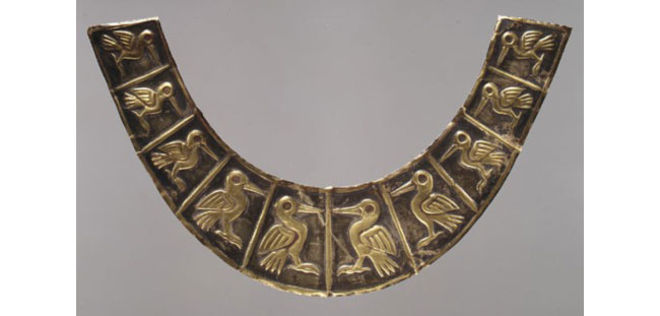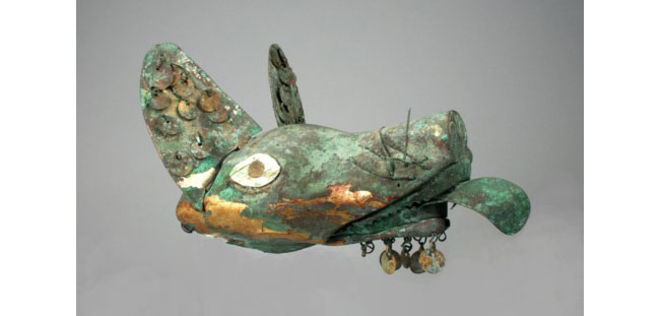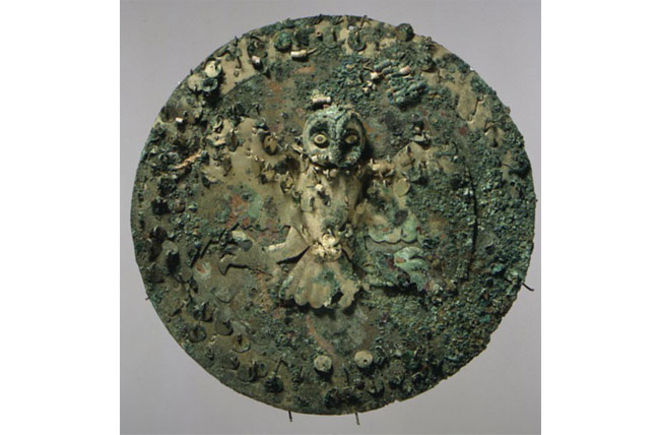
When studying metal historical objects it is important to consider the manufacture and original use of the objects and how that manufacture/use is reflected in the object’s current condition. A close observation of an object in person with a critical attention to detail is an invaluable tool in discerning the minute details that can indicate a method of manufacture or how it was used. Questions that can aid in a close examination of metal objects can include:
- Why does the surface appear to be different on different parts of the object?
- What are the components?
- Why is there so many different colors/tones of gold?
- How was the decoration or negative space made? Was it scratched, punched, cast, chased, or hammered, if so, was the decoration added from the front or back? How was it done? What tools were used?
- How were wires made and joined together? If they are flat how were they flattened?
- If there are six of the same object, were they all of unique manufacture? Or were they made using a replicative process?
- In a bimetalic object, how is the silver and gold combined?
- What was the function of the object? Function dictates the manufacture, and use can be reflected in the wear. Is it?
- What are the auxiliary materials and how are they applied?

During the BGC course “Inca and their Ancestors” utilized these questions, among others, to delve into the significance of ancient Andean metal objects. Beyond the objects themselves, there are a variety of sources that can be pulled from in the study of metal objects and technology of the past. This post will focus on Moche metal objects, however to discern ancient manufacturing methods evidence from a variety of cultures is often pulled in. Occasionally written sources are available, for example Pliny the Elder’s Historia Natura, and the Amarna letters. Depictions of metallurgical technology on other objects can also be studied though there is an ongoing debate over how accurate these depictions are and how useful in determining the processes involved. Examples of such depictions occur everywhere including a Corinthian Greek krater, a Moche ceramic representation, and a frieze from an Egyptian tomb (Figure 2). Archeological excavations and the uncovering of metallurgical sites can reveal more information. Furnaces, tuyeres, casting molds, and metal scrap have been found among other things. Using such findings replication studies are undertaken to learn more.
When looking at the objects themselves a study can begin at the molecular level. The molecular properties of noble and cupric metals, and their common uses either exploiting or resisting these properties. Alloying is an important technological process to manipulate metal. Melting temperature can be altered by alloying two metals with different melting temperatures together. Copper absorbs a lot of gas when molten, making it porous once they are solid again. Alloying can help solve that problem. By incorporating metals that absorb less gas into the copper, like gold silver or tin, the resulting alloy is less likely to become porous. Metals are plastic, malleable (elongate under blows), and ductile (can pull a wire thinner and longer without breaking), strong(supports its own weight).
These fixed properties can also be changed via alloying. The luster, color, density, sound produced, and tendency to corrode can all be changed by alloying. Alloying was used intentionally in the Americas, often for gilding processes. Depletion gilding is one technique. Depletion gilding involves heating it and submerging an alloy of gold and copper, in an acid bath repeatedly. This concentrates the gold particles on the surface creating a golden surface.
The second gilding technique that we explored was electrochemical replacement gilding. One of the only studied sources for this kind of gilding is Loma Negra, a unique Moche site on the far north coast of Peru very far from any other Moche settlements. The Metropolitan Museum of Art has nearly 400 objects from this site and electrochemical gilding is common. Objects from Loma Negra are identified from their style since Loma Negra was not excavated. Electrochemical replacement gilding is characterized by the thinness of the resulting layer of gold, and by the lack of gold in the base material. Heather Lechtman discovered this process and proposed that gold and silver were dissolved in acids that occur naturally in the desert. The acid was then neutralized and copper objects were added. Once the copper object was submerged an exchange of elements occurred. As copper went into the surrounding solution gold deposited on the surface of the object. This exchange continued until the layer of gold was solid enough to prevent any copper from contacting the solution and then stopped. Both Heather Lechtman and the MMA conservation department have successfully replicated this process.
Another unique Moche invention exhibited in Loma Negra objects is silvering on gold. It is still unknown how the Moche achieved this technique. The Moche also created bimetals (gold on one side and silver on the other) and used them to create objects with both gold and silver elements. They would cut shapes out of the bimetal sheet manipulate it for visual effect. These sophisticated technologies are examples of how experimental Moche metalsmiths were.
Analyzing such complex objects requires a variety of different techniques. X-ray analysis can illuminate the methods used in the object’s’ creation. Raking light photography can also be helpful in determining how an object was made. Raking light photography is an imaging technique where the lighting moves around the object as photographs are taken. The photographs are then input into a computer program that extracts information from many different images to produce a single image with enhanced surface texture detail. Both of these imaging techniques can also cut through corrosion to determine tools used, and the hands of more skilled vs learning metalsmiths. Copper reacts with oxygen readily and so corrosion is an issue with any copper object. With time and exposure to the elements copper reacts with oxygen and begins to build up an increasingly thick layer of green copper oxide. This layer can separate any gilding from the surface, obscure surface details, and incorporate nearby materials into its structure (like the beads on Figure 5).

Silver is less radiopaque than gold (it can be seen through more in an x-ray) and this property needs to be taken into account in a bimetal object. The nose plaque fragment in Figure 3 was one of the objects that we were able to look at closely during our visit. It is an example of silvering over gold. The plaque was silver plated and then the silver was polished away on the raised areas so the birds became gold again. How the selective plating of the object was created was discovered using x-rays. The birds are darker on x-rays, even though in an x-ray gold is more opaque than silver, which indicates that the top layer of gold on the birds had been polished away creating a thinner layer of gold in those areas.

One object that was created using an innovative combination of metals and techniques is this fox head (Figure 4). The head is made primarily from gilded copper. The ears and tongue were attached in such a way that his ears and tongue would waggle when it moved. For additional visual effect the teeth were silvered, and the whiskers and tongue were left the red of copper.
A similarly spectacular object that we got to see in the lab is the owl disk in Figure 5. Made of a combination of gilded copper and silvered gold. This object would have exploited the very subtle color differences between the two and would appear to shimmer. This effect would have been magnified by little dangling circles that would have caught the light as the object moved. Physical movement was important in both of these objects and was used to bring them to life. The wings were made separately and were attached to the owl’s body but not to the circle, so they would have flapped. The owl’s head is held on a stick, so, it would move when the disk was moving.

Many of these objects are corroded as a result of oxidation (this is the green in the photographs). However, many of them include fragments of preserved fabric from textiles that were interred close to the metal object. Many of these fragments (which are very fragile and decompose over time) have turned into pseudomorphs (similar to the process of fossilization), in which the copper corrosion transforms into the form of the textile. An example of this transformation can be seen on the owl plaque to the upper right of the owl’s head. Because of the potentially valuable information that these deposits could reveal they have been left on the objects.
Hammering is important in Moche art and is the method used to construct both all three case study objects here. When analyzing a hammered object a linear crystal structure shows it was hammered. Surface embellishment is an important part of hammered sheet work and can be done in a variety of ways: polishing and burnishing, repousse, chasing, engraving, ajoure(open work), artificial patination, gilding and silvering, plating, wire, filigree, inlay, and painting. How these hammered sheets are joined is very important and can be indicative of a cultural style since master metalsmiths would teach their apprentices what they know and pass on the style. There are two different kinds of joining, mechanical and metallurgical. Mechanical joining includes: riveting, tabs, pressure fitting, and wires. Metallurgical joining includes: flow welding, hard and soft soldering, fusing, sweat welding, hammer welding.
The objects from Loma Negra provide an invaluable opportunity to learn about techniques and technology used by ancient Moche metalsmiths. As modern technology advances hopefully we will be able to learn even more about these spectacular objects and the craftsmen that made them. Andean metalsmiths were very sophisticated. Metalsmiths around the world have been solving problems, like gold plating, in different ways for thousands of years and when studying objects it is important to take into account your current biases so as not to assume that the metalsmith that made the objects would have solved problems in the same way that you would. This is especially clear in the case of electrochemical replacement gilding. In Europe fire gilding was the technology that was used until electroplating in the 1800s, which is similar to electro replacement but requires an electric current. The same problem was solved separately in very different ways. I would like to thank Deborah Schorsch for taking the time to speak with us and illuminate this aspect of Pre-Columbian Andean technology.
Lechtman, Heather. “Technologies of Power: The Andean Case.” In Configurations of Power: Holistic Anthropology in Theory and Practice, eds. John Henderson and Patricia Netherly. Ithaca and London: Cornell University Press (1993): 244-280.
Lechtman, Heather. “Pre-Columbian Surface Metallurgy.” Scientific American250, 6 (1984): 56-63.
Schorsch, Deborah. “A Conservator’s Perspective on Ancient Metallurgy.” In Archaeometallurgy in Global Perspective: Methods and Syntheses, eds. Benjamin W. Roberts and Christopher P. Thornton. New York: Springer Science and Business Media (2014): 269-301.
Schorsch, Deborah. “Silver-and-Gold Moche Artifacts from Loma Negra Peru.” Metropolitan Museum Journal 33 (1998): 109-136.
Schorsch, Deborah, Ellen G. Howe and Mark T. Wypyski. “Silvered and Gilded Copper Metalwork from Loma Negra: Manufacture and Aesthetics.” Boletin Museo del Oro 41 (1996): 144-163.
Stanley Smith, Cyril. “On Art, Invention, and Technology.” In A Search for Structure: Selected Essays on Science, Art and History. Massachusetts: The MIT Press (1981): 325-331.
Weisser, Terry Drayman. Gilded Metals: History, Technology and Conservation. London: Archetype Publications in association with the American Institute for Conservation of Historic and Artistic Works, 2000.
Further Reading
Centeno, Silvia and Deborah Schorsch. “Caracterización de Depósitos de Oro y Plata Sobre Artefactos de Cobre del Valle de Piura (Perú) en el Período Intermedio Temprano.” Boletin Museo del Oro 41 (1996): 165-185.
Lechtman, Heather. “Andean Metallurgy in Prehistory.” In Archaeometallurgy in Global Perspective: Methods and Syntheses, eds. Benjamin W. Roberts and Christopher P. Thornton. New York: Springer Science and Business Media (2014): 269-301.
Lechtman, Heather. “A Pre-Columbian Technique for Electrochemical Replacement Plating of Gold and Silver on Copper Objects.” Journal of Metals 31, 12 (1979): 154-160.
Quilter, Jeffrey. The Ancient Central Andes. Routledge (2014): 168-198.
Stone, Rebecca. Art of the Andes: From Chavín to Inca. New York: Thames & Hudson World of Art Series (1995): 91-126.
Walter, Alva and Christopher B. Donnan. Royal Tombs of Sipán. Los Angeles: Fowler Museum, University of California, 1993.
